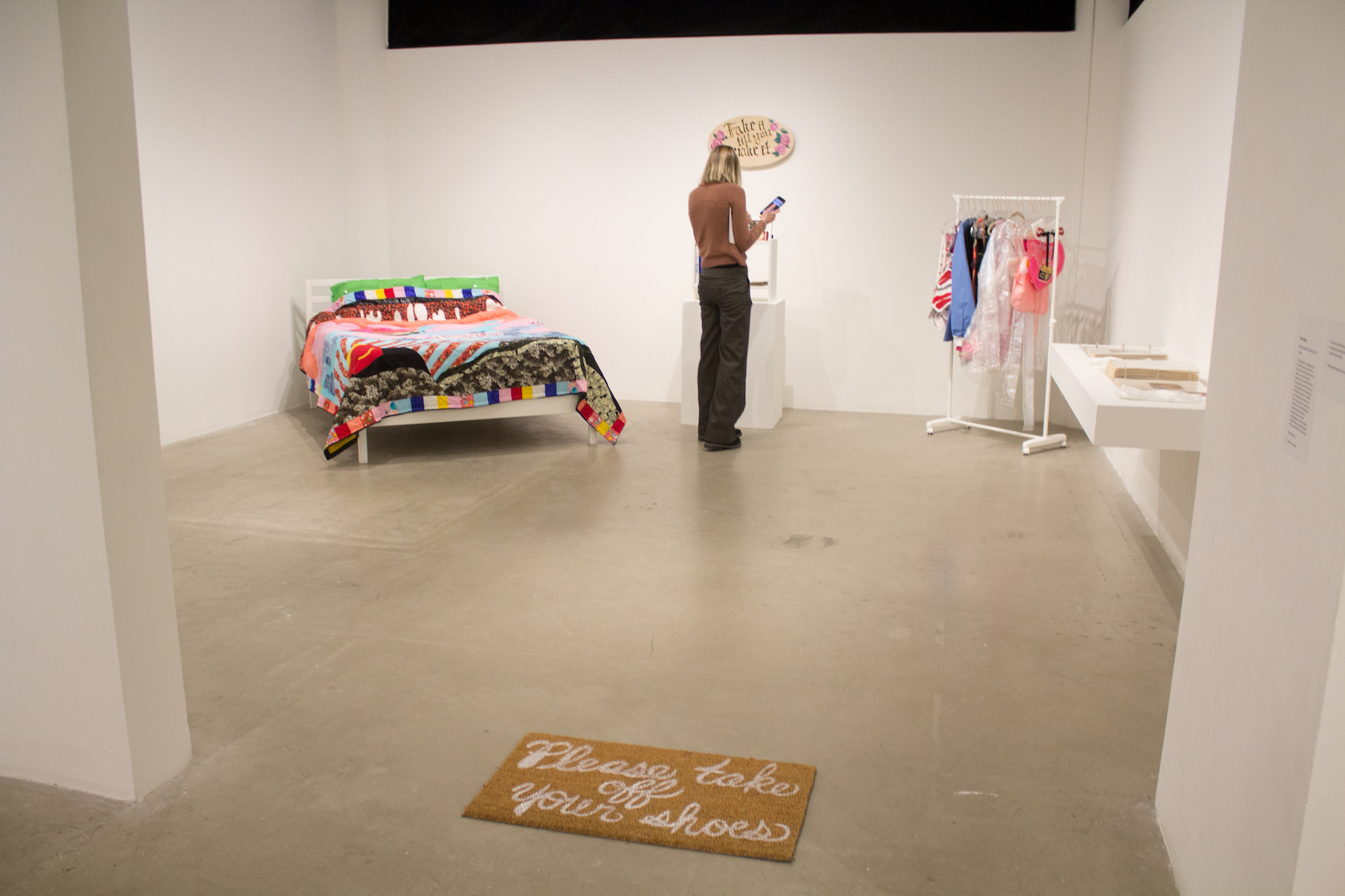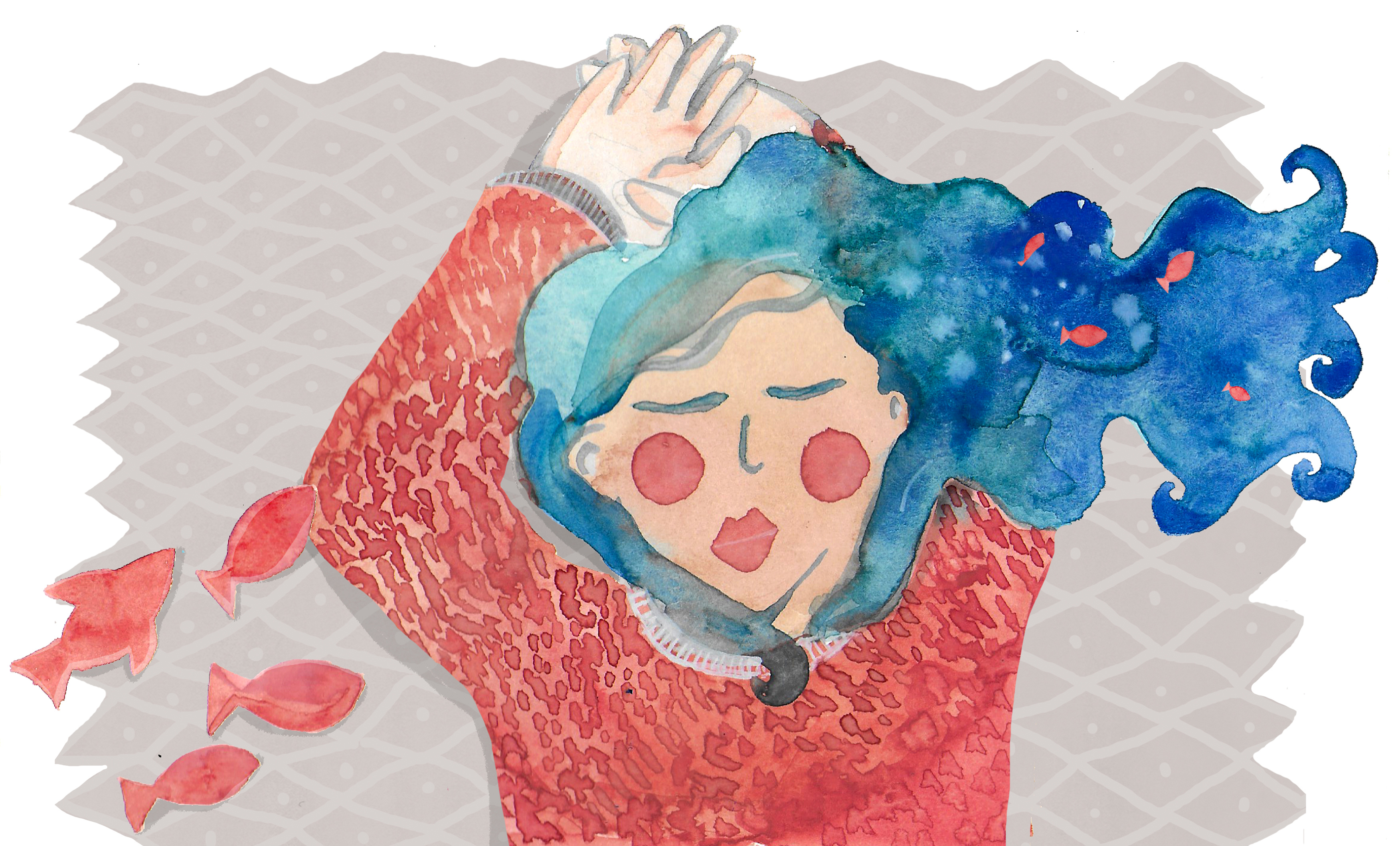
Walking into the School of the Art Institute of Chicago’s (SAIC) Sullivan Galleries to see an Art Therapy exhibition, I expected to find artwork made by patients, with the therapists acting more as guides and curators. I was pleasantly surprised, then, to see an exhibition that showcased the artwork of the Art Therapy students, as well as the ways they use it to reflect on their own identities and engage in internal therapeutic processes.
Titled “The Art of Connection & The Spaces Between,” the show compiled the work of the 24 students of the Master of Arts in Art Therapy and Counseling (MAATC) program’s graduating class. However, instead of focusing on artwork by clients in the hospitals, retirement homes, or rehabilitation centers where the students have worked, the show prioritized the art therapists’ introspection through their own art.
The first piece that stood out to me as I visited the show on January 25th, its opening night, was a large self-portrait of Leah Amaral (MAATC 2019), one of the exhibiting students. I had to get closer to it, though, to grasp its true purpose. Written over and over in cursive handwriting on the subject’s blouse were the words, “I belong, you belong, we belong,” a phrase that gave the piece its title and that, for Amaral, acts as a mantra intended to help visibilize black art therapists.
“It is a way of letting you know that I see you and thank you so much for the work you’ve done before me,” Amaral said, “and also for the people who come after me, to tell them they belong here, I see them, I appreciate them, and finally for myself, telling myself I belong.”
Amaral, a Tarpon Springs, Florida native, said she focuses most of her work on the celebration and liberation of black women. Her role as a therapist, she explained, benefits from creating artwork that makes her question and understand her own beliefs, identities, and struggles.
“Self-reflexivity is part of my therapeutic practice,” she said. “If I don’t know about myself, how can I assess other people and the support that they need?”
As I continued my path around the galleries I found more work that shared this need for self-exploration. The installation “Please Take Off Your Shoes,” for example, showcased art therapist Annie Chang’s (MAATC, 2019) identity as a second generation Korean-American who interns at the Gateway Foundation, a substance abuse treatment center in Chicago. The space recreated her bedroom, with a clothes rack, a bookshelf, and a mattress covered with a quilt that stitched together images of Hello Kitty, the McDonald’s logo, candy, and dollar bills in a combination she described as “kitsch.”

The room also contained two tables with binders full of pictures that Chang compiled into photo diaries, with glossies inside plastic protectors. Next to each book was a white glove, and with it, the artist said, an implicit invitation to put it on and carefully observe the images.
“There are a lot of cultural implications of taking off your shoes, and even gender-based language too, like saying ‘please,’” she said. “Some people don’t bother to come in because they don’t want to put the gloves on or take their shoes off, they’ll just walk by. That’s reflecting on my existence as a Korean-American, being viewed a certain way, where people will just be like, ‘Oh she probably doesn’t even speak English,’ but really I was born in L.A.”
Other pieces in the show, that closed on February 9, were more directly inspired by work with clients, such as “Collecting Stories,” by Ruthe Guerry (MAATC 2019). The piece consisted of 19 black and white found photographs of different moments: a busy outdoor market scene, three women smiling and standing outside together, a couple dancing in an alley at night. The artist pasted these images on larger pieces of paper, where she drew the imagined surroundings of the particular moment portrayed in the picture. The project is inspired by the artist’s work with older adults, many of whom have been diagnosed with Alzheimer’s Disease. The idea of exercising creativity to “fill in” a partially lost memory struck me as powerful in its simplicity.

Another equally powerful piece was “The Eleventh Hour,” by artist Jessica Sandacz (MAATP 2019), who has worked with older adults and patients requiring end-of-life care. She set 12 clocks on a wall, arranged in two rows of six. All the clocks were the same size and color, but each one behaved uniquely; a couple of them ran backwards, some didn’t move at all, and others moved at different speeds. Two of them had a few numbers covered with white pieces of paper, and another one was entirely blank. Expecting people with different mental conditions to perceive time in a single way, the wall text suggested, is about as futile as waiting for all the clocks to eventually synchronize.

Particularly powerful were works that simultaneously displayed an artist’s emotional introspection and experience with clients, such as those by Mikey Anderson (MAATP, 2019). An artist from Chicago’s South Side, Anderson’s art therapy practice focuses on uniting and empowering the queer community through crafting, whether by embroidery, stitching, quilting, or creating plush toys.
“I’m just trying to make work that is cuddly and cute and inviting, but has an underlying message,” he said as he clutched a plush toy in the shape of a rainbow, one of the many elements of a wall installation that comprised his fiber work. The centerpiece of his series is an American flag made as a quilt and an invitation to lift it. On the other side, over patches of bright colors, are the words, “we are queer voices.”
After spending close to two hours in the show and talking to a few of the participating artists, I could feel a different dynamic from that of other exhibitions that I had seen in the same space. Though the artists’ identities and target therapy groups differed, their pieces all depicted the process of attaining empathy and emotional support.
I was not alone in this sentiment. For Kaity O’Reilly, a student in the Masters in Arts Administration and Policy department at SAIC, a gallery presenting the work of artists beyond MFA programs was a refreshing sight.
“It’s nice for art therapy to get use of the Sullivan Space because it’s often a space that the studio artists get a lot of room to play with,” she said. “The art therapy students are practicing artists, but their art feels different. There’s a different energy in the gallery, and you can feel the process of both the therapy and the healing either for themselves as artists or through their work with their patients.”







